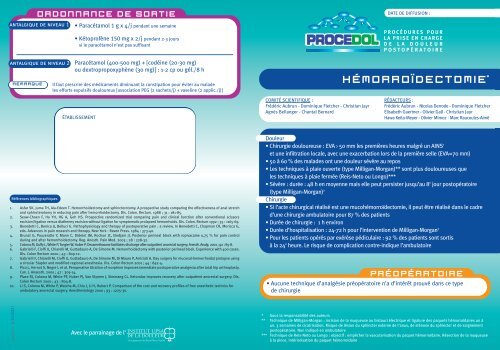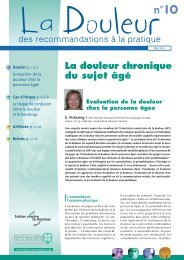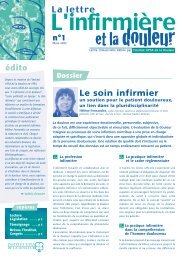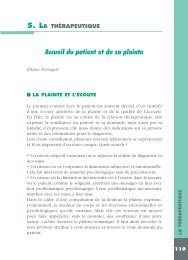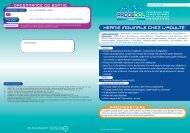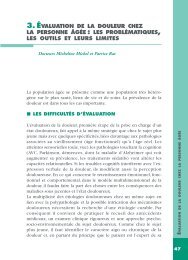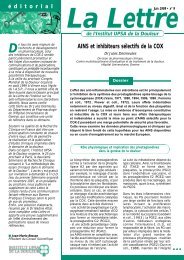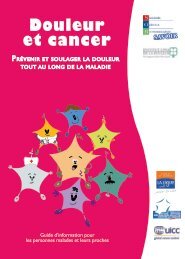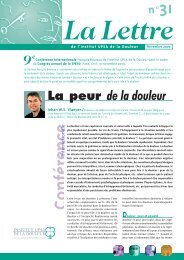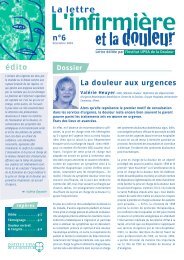Procedol :Hémorroïdectomie - Institut upsa de la douleur
Procedol :Hémorroïdectomie - Institut upsa de la douleur
Procedol :Hémorroïdectomie - Institut upsa de la douleur
You also want an ePaper? Increase the reach of your titles
YUMPU automatically turns print PDFs into web optimized ePapers that Google loves.
ORDONNANCE DE SORTIE<br />
antalgique <strong>de</strong> niveau 1<br />
antalgique <strong>de</strong> niveau 2<br />
REMARQUE<br />
• Paracétamol 1 g x 4/j pendant une semaine<br />
• Kétoprofène 150 mg x 2/j pendant 2-3 jours<br />
si le paracétamol n’est pas suffisant<br />
Paracétamol (400-500 mg) + [codéine (20-30 mg)<br />
ou <strong>de</strong>xtropropoxyphène (30 mg)] : 1-2 cp ou gél./8 h<br />
Il faut prescrire <strong>de</strong>s médicaments diminuant <strong>la</strong> constipation pour éviter au ma<strong>la</strong><strong>de</strong><br />
les efforts expulsifs douloureux [association PEG (2 sachets/j) + vaseline (2 applic./j)]<br />
DATE DE DIFFUSION :<br />
PROCÉDURES POUR<br />
LA PRISE EN CHARGE<br />
DE LA DOULEUR<br />
POSTOPÉRATOIRE<br />
HÉMORROÏDECTOMIE *<br />
ÉTABLISSEMENT<br />
COMITÉ SCIENTIFIQUE :<br />
Frédéric Aubrun - Dominique Fletcher - Christian Jayr<br />
Agnès Bel<strong>la</strong>nger - Chantal Bernard<br />
RÉDACTEURS :<br />
Frédéric Aubrun - Nico<strong>la</strong>s Derro<strong>de</strong> - Dominique Fletcher<br />
Elisabeth Gaertner - Olivier Gall - Christian Jayr<br />
Hawa Keita-Meyer - Olivier Mimoz - Marc Raucoules-Aimé<br />
Références bibliographiques<br />
1. Asfar SK, Juma TH, A<strong>la</strong>-E<strong>de</strong>en T. Hemorrhoi<strong>de</strong>ctomy and sphincterotomy. A prospective study comparing the effectiveness of anal stretch<br />
and sphincterotomy in reducing pain after hemorrhoi<strong>de</strong>ctomy. Dis. Colon. Rectum. 1988 ; 31 : 181-85.<br />
2. Seow-Choen F, Ho YH, HG A, Goh HS. Prospective randomized trial comparing pain and clinical function after conventional scissors<br />
excision/ligation versus diathermy excision without ligation for symptomatic pro<strong>la</strong>psed hemorrhoids. Dis. Colon. Rectum 1992 ; 35 : 1165-69.<br />
3. Bene<strong>de</strong>tti C, Bonica JJ, Belluci G. Pathophysiology and therapy of postoperative pain : a review. In Bene<strong>de</strong>tti C, Chapman CR, Moricca G,<br />
eds. Advances in pain research and therapy. New York : Raven Press. 1984 : 373-40.<br />
4. Brunat G, Pouzeratte Y, Mann C, Di<strong>de</strong>lot JM, Rochon JC, Eledjam JJ. Posterior perineal block with ropivacaine 0,75 % for pain control<br />
during and after hemorrhoi<strong>de</strong>ctomy. Reg. Anesth. Pain Med. 2003 ; 28 : 228-32.<br />
5. Coloma M, Duffy L, White P, Tongier W, Huber P. Dexamethasone facilitates discharge after outpatient anorectal surgery. Anesth. Analg. 2001 ; 92 : 85-8.<br />
6. Gabrielli F, Cioffi U, Chiarelli M, Guttadauro A, De Simone M. Hemorrhoi<strong>de</strong>ctomy with posterior perineal block. Experience with 400 cases.<br />
Dis. Colon Rectum 2000 ; 43 : 809-12.<br />
7. Gabrielli F, Chiarelli M, Cioffi U, Guttadauro A, De Simone M, Di Mauro P, Arriciati A. Day surgery for mucosal-hemorrhoidal pro<strong>la</strong>pse using<br />
a circu<strong>la</strong>r Stapler and modified regional anesthesia. Dis. Colon Rectum 2001 ; 44 : 842-4.<br />
8. Pico L, Hernot S, Negre I, et al. Peroperative titration of morphine improves immediate postoperative analgesia after total hip arthrop<strong>la</strong>sty.<br />
Can. J. Anaesth. 2000 ; 47 : 309-14.<br />
9. P<strong>la</strong>ce RJ, Coloma M, White PF, Huber PJ, Van Vlymen J, Simmang CL. Ketoro<strong>la</strong>c improves recovery after outpatient anorectal surgery. Dis.<br />
Colon Rectum 2000 ; 43 : 804-8.<br />
10. Li S, Coloma M, White P, Watcha M, Chiu J, Li H, Hubert P. Comparison of the cost and recovery profiles of free anesthetic technics for<br />
ambu<strong>la</strong>tory anorectal surgery. Anesthesiology 2000 ; 93 : 1225-30.<br />
Douleur<br />
• Chirurgie douloureuse : EVA › 50 mm les premières heures malgré un AINS 1<br />
et une infiltration locale, avec une exacerbation lors <strong>de</strong> <strong>la</strong> première selle (EVA=70 mm)<br />
• 50 à 60 % <strong>de</strong>s ma<strong>la</strong><strong>de</strong>s ont une <strong>douleur</strong> sévère au repos<br />
• Les techniques à p<strong>la</strong>ie ouverte (type Milligan-Morgan)** sont plus douloureuses que<br />
les techniques à p<strong>la</strong>ie fermée (Reis-Neto ou Longo)***<br />
• Sévère : durée : 48 h en moyenne mais elle peut persister jusqu’au 8 e jour postopératoire<br />
(type Milligan-Morgan) 2<br />
Chirurgie<br />
• Si l’acte chirurgical réalisé est une mucohémorroï<strong>de</strong>ctomie, il peut être réalisé dans le cadre<br />
d’une chirurgie ambu<strong>la</strong>toire pour 87 % <strong>de</strong>s patients<br />
• Durée <strong>de</strong> chirurgie : 1 h environ<br />
• Durée d’hospitalisation : 24-72 h pour l’intervention <strong>de</strong> Milligan-Morgan 3<br />
• Pour les patients opérés par exérèse pédicu<strong>la</strong>ire : 92 % <strong>de</strong>s patients sont sortis<br />
à <strong>la</strong> 24 e heure. Le risque <strong>de</strong> complication contre-indique l’ambu<strong>la</strong>toire<br />
PRÉOPÉRATOIRE<br />
• Aucune technique d’analgésie préopératoire n’a d’intérêt prouvé dans ce type<br />
<strong>de</strong> chirurgie<br />
2540321<br />
Avec le parrainage <strong>de</strong> l’<br />
* Sous <strong>la</strong> responsabilité <strong>de</strong>s auteurs<br />
** Technique <strong>de</strong> Milligan-Morgan : incision <strong>de</strong> <strong>la</strong> muqueuse au bistouri électrique et ligature <strong>de</strong>s paquets hémorroïdaires un à<br />
un. 3 semaines <strong>de</strong> cicatrisation. Risque <strong>de</strong> lésion du sphincter externe <strong>de</strong> l’anus, <strong>de</strong> sténose du sphincter et <strong>de</strong> saignement<br />
postopératoire. Non indiqué en ambu<strong>la</strong>toire<br />
*** Technique <strong>de</strong> Reis-Neto ou Longo : objectif : empêcher <strong>la</strong> vascu<strong>la</strong>risation du paquet hémorroïdaire. Résection <strong>de</strong> <strong>la</strong> muqueuse<br />
à <strong>la</strong> pince. Intériorisation du paquet hémorroïdaire
HÉMORROÏDECTOMIE<br />
PROCÉDURES POUR<br />
LA PRISE EN CHARGE<br />
DE LA DOULEUR<br />
POSTOPÉRATOIRE<br />
• TYPE D’ANESTHÉSIE : • L’association anesthésie locorégionale et sédation permet l’anesthésie chirurgicale et l’analgésie<br />
postopératoire précoce dans <strong>de</strong> bonnes conditions, et est adaptée à l’anesthésie ambu<strong>la</strong>toire<br />
• Si le patient a reçu une anesthésie générale ou une rachianesthésie, l’analgésie est débutée au<br />
bloc opératoire 7<br />
BLOC OPÉRATOIRE<br />
PRODUIT/VOIE<br />
MODALITÉS POSOLOGIE BÉNÉFICES ATTENDUS REMARQUES<br />
LOCORÉGIONALE<br />
ropivacaïne 0,75 %<br />
bloc du périnée<br />
REMARQUE<br />
paracétamol<br />
1 g iv<br />
kétoprofène<br />
100 mg iv<br />
néfopam<br />
20 mg iv<br />
morphine<br />
1 mg/ml iv<br />
4-8<br />
ALTERNATIVES<br />
10<br />
9<br />
PRODUIT/VOIE<br />
morphine<br />
1 mg/ml iv<br />
ALTERNATIVE<br />
Bloc du périnée<br />
Perfusion sur 15 min<br />
à <strong>la</strong> fermeture<br />
Perfusion sur 15 min<br />
à <strong>la</strong> fermeture<br />
40 ml<br />
soit 300 mg<br />
Analgésie suffisante<br />
pour 75 % <strong>de</strong>s patients<br />
pour les premières heures<br />
postopératoires et<br />
efficace 10-15 h pour<br />
plus <strong>de</strong> 50 % <strong>de</strong>s patients<br />
Analgésie par anticipation<br />
Analgésie par anticipation<br />
et synergie avec<br />
morphinique<br />
Perfusion <strong>de</strong> 20 mg sur 15 min<br />
à <strong>la</strong> p<strong>la</strong>ce du kétoprofène ou du paracétamol si contre-indication, ou associé aux 2<br />
0,15 mg/kg, 20-30 min avant <strong>la</strong> fin <strong>de</strong> <strong>la</strong> chirurgie et en cas d’anesthésie générale<br />
Titration par bolus<br />
quand patient évaluable<br />
dès EVA › 30 mm<br />
PARENTÉRALE<br />
Dose <strong>de</strong> charge<br />
1-3 mg/5 min<br />
selon l’âge<br />
Adaptation aux besoins<br />
du patient<br />
Réalisation du bloc sous<br />
couvert d’application <strong>de</strong><br />
crème lidocaïne et/ou<br />
<strong>de</strong> midazo<strong>la</strong>m IV et/ou<br />
<strong>de</strong> rémifentanil [bolus <strong>de</strong><br />
0,5-1 µg/kg ; entretien<br />
0,1-0,3 µg/kg/min]<br />
La sédation pendant l’intervention comprend : propofol 25 µg/kg/min au pousse-seringue électrique<br />
(+/- fentanyl ou sufentanil), ou à 1-2 µg/ml en anesthésie intraveineuse à objectif <strong>de</strong> concentration<br />
1 g<br />
50-100 mg<br />
Pic d’efficacité : 1-2 h<br />
Pic d’efficacité : 1 h<br />
Facteurs limitants :<br />
âge › 75 ans, digestifs,<br />
rénaux, allergiques et<br />
hémorragiques<br />
(Voir fiche Sujet Âgé)<br />
SSPI<br />
MODALITÉS POSOLOGIE BÉNÉFICES ATTENDUS REMARQUES<br />
Surveil<strong>la</strong>nce continue <strong>de</strong><br />
<strong>la</strong> conscience, fréquence<br />
respiratoire et score <strong>de</strong><br />
<strong>douleur</strong><br />
paracétamol<br />
1 g iv<br />
kétoprofène<br />
100 mg iv<br />
néfopam<br />
20 mg iv<br />
morphine<br />
10 mg/ml sc<br />
PRODUIT/VOIE<br />
ALTERNATIVES<br />
paracétamol 1 g po<br />
kétoprofène 150 mg po<br />
ALTERNATIVE<br />
tramadol 50 mg po<br />
9<br />
SECTEUR D’HOSPITALISATION<br />
MODALITÉS POSOLOGIE BÉNÉFICES ATTENDUS REMARQUES<br />
Perfusion sur 15 min<br />
Perfusion sur 15 min<br />
Systématique<br />
Systématique<br />
PARENTÉRALE<br />
1 g x 4/j jusqu’à<br />
reprise alimentation<br />
50 mg x 4/j<br />
ou 100 mg x 3/j<br />
pendant 2 j max<br />
Perfusion <strong>de</strong> 20 mg sur 15 min toutes les 4 h<br />
RELAIS<br />
1 cp x 4/j<br />
pendant 5-7 j<br />
150 mg x 2/j<br />
pendant 2-3 j<br />
1-2 gél. x 4/j<br />
Entretien analgésie<br />
Entretien analgésie<br />
Complément<br />
analgésie<br />
locorégionale<br />
Complément<br />
analgésie<br />
locorégionale<br />
Analgésie continue<br />
Surveil<strong>la</strong>nce,<br />
tolérance digestive<br />
fonction rénale et<br />
saignement<br />
postopératoire<br />
10 mg x 6/j à <strong>la</strong> <strong>de</strong>man<strong>de</strong>, en tant qu’antalgique <strong>de</strong> secours, notamment après chirurgie à p<strong>la</strong>ie ouverte<br />
Si le paracétamol<br />
est insuffisant<br />
Dé<strong>la</strong>i d’action :<br />
15-45 min ;<br />
Pic d’efficacité :<br />
120 min ;<br />
Durée d’action : 6 h<br />
néfopam 20 mg iv<br />
Perfusion <strong>de</strong> 20 mg sur 15 min, si l’injection n’a pas été réalisée au bloc opératoire


